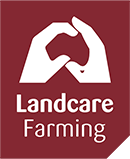
20-years of action on ACT farm results in biodiversity and sustainability gains
Steps taken by ACT producer Sarah Lindsay to protect waterways and improve vegetation have paid dividends with both business and biodiversity gains as the result.
Sarah has been grazing merino sheep and beef cattle on Guises Flat for 22 years, supplementing her income with eco-tourism and a part-time job in Canberra.
Her 200ha property backs on to the Rob Roy National Park and Gigerline Nature Reserve and features a large farm dam which flows into Guises Creek and on to the Murrumbidgee River. Recognising the importance of this water feature to both the farm and the wider landscape, Sarah has been progressively fencing off the waterways to protect them from stock damage, as well as further reducing erosion and sediment runoff by using fallen sticks and logs to create leaky weirs in the gullies that have formed across the property.
“I’ve discovered how important it is to slow the water. Not only to help with erosion but also to help get the water to spread out as far as it can to rehydrate the landscape,” said Sarah. “I’ve got over 20 years of doing restoration work here, so I can really see the results. Having completely excluded stock from the waterways has dramatically improved water quality, minimised erosion and enabled the natural revegetation of the riparian zones.”
Sarah’s property sits right next to the ACT-NSW border and is nestled between remnant woodlands and a major road, with steep hills both to the west and east of the valley. Bird species such as honeyeaters use the area as a migration pathway between the coastal environments, the tablelands and Australian Alps.
To protect and improve this significant habitat she has worked with the support of Greening Australia to plant mixed-species bird corridors east-west across the property to provide linkage habitat through the valley for migratory birds.
Since 2004 Sarah has planted over 6000 trees and shrubs covering nearly 30 percent of the property. Regular bird surveys by the Canberra Ornithologist Group have found a diverse array of woodland birds using the revegetation sites, including regular sightings of threatened Scarlet Robins. This revegetation has reduced available grazing pasture, but has positive impacts on stock health by improving grazing quality and also providing shelter which can be critical during vulnerable times such as lambing. It has also increased the tourism values of the property, with visitors being able to take scenic walks from the farm house down to the lake where kayaks are waiting for the adventurous to paddle out and join the grebes and other waterfowl.
Despite Sarah’s hard work to improve groundcover and revegetate the farm, sporadic roadworks on the adjacent Monaro Highway often inadvertently led to fast, funnelled water flows from under the road and across the landscape, disturbing the topsoil and creating erosion gullies. To counteract this, Sarah hired a local contractor to construct a simple pond that disrupts the flow of water from the highway through the property, and added loose branches and rocks from nearby to further slow the flow. Following the works erosion slowed immediately, and within a year the barren edges started to regenerate naturally.
Landcare ACT CEO Karissa Preuss says that the restoration work Sarah has engaged in on her property is a reflection of the wider commitment to sustainable land practices held by many rural landholders in the area.
“Many farmers in our region demonstrate an approach to agriculture that prioritises environmental stewardship,” said Karissa.
Sarah has been largely self-taught in the theory and practice of sustainable land management via much reading and seeking advice from neighbours as well as the experts from her local Landcare group, Southern ACT Catchment Group. Her work has at times challenged the status quo in the local farming community, being an “outspoken woman trying something different”, but Sarah says her neighbours are often curious about her success.
When Sarah’s first action was to fence off waterways to exclude livestock, neighbours noticed this and contacted her to find out more about the “Sarah way” of fencing. Since then, Sarah has used an “actions louder than words” approach to advocacy, and notes that every new instalment on her property is observed with interest by the local community.
This case study was produced as part of the Landcare Farming Innovations in Agriculture Series. Supported by the Australian Government’s National Landcare Program, the Landcare Farming Innovations in Agriculture Series is managed in partnership by Landcare Australia and the National Landcare Network.
More Innovations in Agriculture stories from Landcare ACT:



